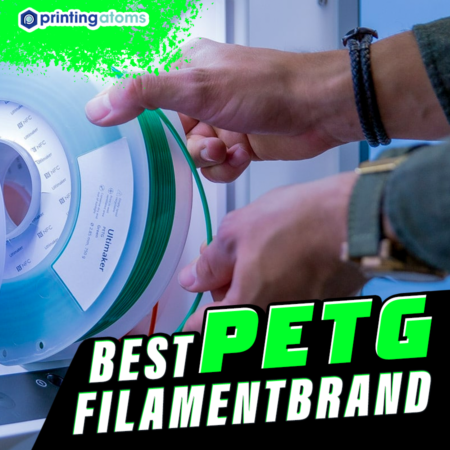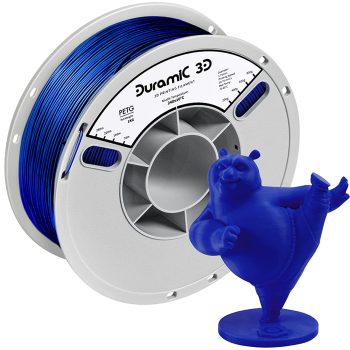- Last Updated: January 12, 2024
-
 Jackson O'Connell
Jackson O'Connell
 For 3D prints that are strong and durable, but still pretty easy to print, PETG is perhaps the best filament material.
For 3D prints that are strong and durable, but still pretty easy to print, PETG is perhaps the best filament material.
PETG offers significantly increased strength, durability, UV resistance, and other mechanical properties over other materials, like PLA, but without the excessive hardware requirements and printing difficulty of materials like ABS.
Overall, it’s a great choice for any type of print, especially those that will face physical stresses or be outdoors.
There are many different brands of PETG filament on the market today, but not all of them are worth your time or money.
Read on to learn about the best PETG filaments that you can buy and some more information about this material!
Top PETG Filament Brands At A Glance
1. Hatchbox PETG Filament (Best Value)
2. TECBEARS PETG Filament (Best Choice)
3. eSun PETG Filament (Premium Choice)
4. Duramic PETG Filament
5. Sunlu PETG Filament
6. Polymaker PolyLite PETG Filament
First up, Hatchbox is a popular manufacturer of high-quality, low-cost 3D printing filaments.
Their PETG filament comes in a wide variety of colors, like orange, black, green, red, blue, light orange, and more. According to the manufacturer, Hatchbox PETG filament maintains a +/- 0.03 mm diameter tolerance, which is a good indicator that you shouldn’t experience any filament jams due to diameter issues.
One of the best parts about this filament is that it’s super easy to print.
Moreover, Hatchbox PETG filament has a recommended nozzle temperature between 230 and 260 °C, which isn’t too high but isn’t super low either. Additionally, reviewers have mentioned that they could consistently achieve high-quality prints easily with this filament, proving that Hatchbox PETG is a reliable option.
According to Hatchbox, this PETG filament is also odorless, which is great because having to deal with a plastic scent while around your 3D printer can be both irritating and unhealthy. Another benefit of this filament is that it offers very high strength for models printed in it with minimal warping, as with most PETG filaments.
The filament also costs a few dollars above $20 for a kilogram spool, which is a little more than some other options on this list. Unfortunately, though, Hatchbox PETG’s colors aren’t as vibrant as one might hope. Many users cite that the different colors of their filament are a little dull when compared to other brands.
Pros
- Basically odorless
- Great diameter tolerance of +/- 0.03 mm for reduced chance of hot end jams
- Consistently produces high-quality prints
- Comes in many colors
- Yields strong models
- Minimal warping and stringing for an easy printing experience
Cons
- Filament colors aren’t very shiny or vibrant
- Costs a few dollars more than other PETG filaments
- Uses decently high printing temperatures
Second, TECBEARS might be a less-popular filament manufacturer than the other brands on this list, but their PETG filament is still deserving of mention as it’s very high quality. The filament is known for yielding a high level of dimensional accuracy and detail on 3D prints. Numerous user reviews also confirm the manufacturer’s claim that this PETG filament offers smooth extrusion, so prints come out better and with fewer defects.
Parts printed in this PETG filament are very strong too due to the high layer-to-layer adherence that the material brings. According to the manufacturer, this PETG filament is also 100% environmentally friendly due to its use of natural raw materials that should be able to be recycled.
Sadly, TECBEARS PETG filament only comes in four colors (black, grey, white, and blue). This means you’ll have to paint models after printing to get the part to be another color.
TECBEARS uses a patented clog-free manufacturing process to ensure that your PETG filament doesn’t jam your extruder or hot end, which makes the printing process easier. On a similar note, TECBEARS claims that their PETG filament will have less stringing and warping compared to other options. This further contributes to the filament offering an easy printing experience as well as better prints.
Pros
- Reduced chance of stringing and warping on prints for easier printing experience
- Made from 100% eco-friendly materials
- Yields strong prints due to high layer-to-layer bond strength
- Produces very dimensionally accurate models
- Consistently smooth extrusion and high-quality prints
Cons
- Doesn’t come in many colors
- Known to be somewhat hygroscopic which can cause printing issues
Third, eSun is a developer of 3D printing accessories, including dry boxes as well as a wide variety of filaments. eSun PETG filament is highly-regarded in the community, known for its extra strength compared to other PETG filaments on the market. This is likely a result of the purity (high PETG composition) of the filament and the strong layer-to-layer bonds that models printed in this filament have.
On top of being very strong, eSun PETG is a tad bit flexible too, which makes it very impact resistant and durable. User reviews confirm this as many mention that models made in eSun PETG filament are pretty tough.
The filament comes in over ten colors, including a transparent white option which is very useful for printing see-through objects like a lampshade. The other colors, like red and black, are also very shiny. While you may like shiny filaments, note that users have had issues with the excessive shiny-ness resulting in their printer’s filament sensor not detecting the filament and causing printing issues.
One of the best parts about eSun’s PETG filament is that it’s very easy to print. According to the manufacturer, the filament has minimal warping, tangling, and clogging, which all contribute to a smooth printing experience. eSun also mentions that their PETG filament is great for producing details on 3D models.
Pros
- Minimal warping, tangling and clogging for an easy printing experience
- Smooth and consistent extrusion that yields a lot of detail in prints
- Produces very strong models due to good layer-to-layer bonds
Cons
- Shininess of filament can mess up filament runout sensors
- High diameter tolerance of +/- 0.05 mm could cause hot end jams
Duramic is another manufacturer of 3D printing filaments and Duramic PETG filament is another great PETG blend that’s worth including in this list due to its easy printability. Moreover, Duramic states that their PETG filament won’t tangle or clog, resulting in an error-less printing experience. Duramic also points out that stringing shouldn’t be much of a problem with their PETG filament!
What’s especially impressive about Duramic PETG filament is that it’s said to be bubble-free, and this means that, despite PETG being naturally hygroscopic, the filament shouldn’t absorb too much moisture from the air. This further makes the filament easier to work with and results in a more consistent extrusion as the filament will come out of the nozzle much smoother.
Duramic PETG comes in 14 different colors, like pink, black, silver, and orange. Sadly, the filament has a relatively high diameter tolerance of +/- 0.05 mm, which indicates that the filament’s diameter inconsistencies could cause a hot en jam. Lastly, it’s also worth noting that the manufacturer of the filaments states that the PETG is sourced from 100% environmentally-friendly materials.
Pros
- Available in 14 different colors
- Sourced from eco-friendly materials
- Shouldn't be as hygroscopic as other PETG filaments
- Tangle and clog-free for an easy printing experience
Cons
- Relatively high diameter tolerance could lead to hot end jams
- User reviews suggest that the filament isn’t super consistent in quality
Sunlu makes a lot of different 3D printing-related products, like dry boxes, printers, and, of course, different filaments. Sunlu PETG filament is known for yielding very shiny and vibrant models, but, unfortunately, it only comes in a few different colors. If you want to make a model color that the filament doesn’t come in, you’ll have to paint the PETG print afterward.
One of the best parts of Sunlu PETG filament is its low diameter tolerance of +/- 0.02 mm. With this low of diameter, you’re unlikely to run into hot end jams or clogs due to diameter inconsistencies and this point is confirmed by the manufacturer who mentions that the filament is “clog-free”.
Sunlu also states that its PETG filament doesn’t bubble. However, this claim is likely not 100% true as any PETG filament is somewhat hygroscopic. For this reason, with Sunlu PETG filament and any other PETG filament, we recommend storing the plastic in a dry box or airtight container to ensure that no bubbles occur during printing so the filament extrusion will be smoother.
Pros
- Low diameter tolerance
- Clog-free and easy to print
- Shiny and vibrant visual appeal
Cons
- The bubble-free claim is likely an advertising method as PETG plastic is naturally hygroscopic
- Shiny visual effect might mess with a printer’s filament sensor
- Not available in many colors
The last PETG filament we’ll be going over is from Polymaker, a developer of a wide array of 3D printing filaments, like PLA, PLA+, and, of course, PETG. Specifically, we’ll be going over Polymaker’s PolyLite PETG filament, which is the company’s special version of PETG filament developed for extra strength and durability for printed models. Moreover, parts printed in PolyLite PETG have increased toughness and heat resistance compared to other PETG filaments.
Although PolyLite PETG offers improved mechanical properties over other PETG filament options, it’s still relatively easy to print. Furthermore, the filament only requires a nozzle and bed temperature of 235 and 70°C, respectively. On top of the low-temperature requirements, Polymaker states that you can print the filament with a speed of 60 mm/s, which is pretty fast for PETG.
The manufacturer of the filament also confirms that the filament is anti-warping and jam-free, which should further make PolyLite PETG easy to print. The filament costs a few extra bucks than the other options on this list, but this slight increase in cost may be worth it if you really want some extra strength while keeping the ease of printability.
Some other great features about this filament are that Polymaker uses a recyclable cardboard spool that makes the product more eco-friendly. The spool also has marked lines that indicate how many grams of filament remain, which is super useful for determining if you have enough filament for a certain print. PolyLit PETG also comes in over 14 different colors, like black, white, green, teal, orange, transparent and more!
Pros
- Comes in many colors
- Recyclable spool with markings for how much filament is left
- Easy to print with low-temperature requirements
- Enhanced mechanical properties like strength and heat resistance compared to other PETG filaments
Cons
- Slightly more expensive than other PETG filaments
- The diameter tolerance is unknown
What is PETG?

The difference between PETG and PET is that the former has a glycol modification that makes it easier to 3D print, which is why you’ll see many more PETG filaments than PET filaments.
But what is PETG really?
PETG is a 3D printable thermoplastic that’s sourced from oil derivatives. Although plastic comes from a non-renewable resource, you can usually recycle PET and PETG parts, so it’s not as environmentally unfriendly as other oil-based materials like ABS.
Still, plastic isn’t considered biodegradable.
Other features of the plastic include its high strength, durability, and impact resistance. These all make the plastic great for producing models that will function under physical stresses like parts on a moving robot or a hook.
Some more advantages of PETG are its resistance to:
- UV rays (sunlight)
- High temperatures
- Water
- Solvent chemicals (e.g. acetone), and
- Scratching and wear
These factors are a major contributor to why PETG is one of the best plastics for printing outdoor models because PETG prints won’t deform under sunlight or from solvents as PLA models will.
As we mentioned, PETG is also not too difficult to print. The material typically can be printed using a nozzle and bed temperature of 250 °C and 75 °C, respectively. While stringing and over adhesion to the build plate are common issues with PETG, generally, the material isn’t too sensitive to slicer settings, making it pretty easy to achieve decent-quality 3D prints.
Finally, the material also isn’t too expensive, costing around $20 per kilogram spool.
Is PETG Toxic?

Now that we’ve gone over what PETG is and a few of the best PETG filaments on the market, it’s time to answer some important questions about the material.
First up: “Is PETG Toxic?”
The short and basic answer is no.
Although PETG comes from oil most of the time, it’s not a toxic material like other oil-based materials such as ABS. Moreover, neither the raw plastic itself nor the fumes that may come with printing PETG have been proven toxic according to many studies. This means you shouldn’t worry about getting sick from using or printing PETG plastic.
Is PETG Food Safe?

As PETG isn’t toxic, it makes sense that it’s also considered food safe. By “food safe”, we mean you can print food-contact items, like a fruit or candy bowl, in PETG and not worry about digesting harmful chemicals.
Some PETG filaments have an official approval from the United States Food and Drug Administration (FDA) that proves the filament is safe for food contact purposes.
However, non-FDA-approved PETG filaments are usually food safe too, as long as the specific blend of PETG doesn’t contain toxic additives. Usually, the manufacturer of the specific PETG filament will mention if you’re safe to print food-contact items in the filament or not.
What is PETG Good For?

So, what is PETG good for? A better question might be “what is PETG not good for?” because PETG is an all-around excellent 3D printable thermoplastic that suits many purposes.
First off, PETG is great for printing models that will face physical stresses, such as gears on a robot or a doorstop. That’s because PETG is both very strong and somewhat impact resistant. The plastic also boasts other impressive mechanical properties like heat and scratch resistance.
Second, PETG is one of the best 3D printer filaments for outdoor parts due to PETG’s natural UV and heat resistance that will prevent PETG prints from deforming under sunlight. I like 3D printing pots for my plants with PETG.
Lastly, PETG is great for printing food-contact items, as we’ve explained, because the material is non-toxic and usually food safe.
What to Consider When Using PETG?

While PETG isn’t as difficult to print as other filament materials, there are still some things to keep in mind when using PETG.
The first consideration is the printability of the material. You’ll likely have some issues with stringing on prints, so it’s important to use a higher-than-normal retraction distance and speed on your slicer profile.
This will help keep stringing to a minimum.
Second, because PETG is a natural hygroscopic material, you should consider keeping your PETG filament in a dry box or air-tight container as we’ve mentioned. This will prevent the filament from absorbing moisture from the air, so your printer’s extrusion will be smoother with less bubbling.
Third and lastly, you should consider your print’s bed adhesion. PETG prints tend to stick very well to smooth surfaces, so make sure that you use an interface or medium layer like glue over your build plate so that you don’t accidentally break your print bed when removing prints.
Conclusion
Overall, PETG is one of the best 3D printer filament materials you can get because of its high strength and durability, low cost, food safety, and other great properties.
While there are many different PETG filaments out there, few are as excellent as the ones we mentioned in the sections above. No matter what PETG filament you choose, though, make sure to keep in mind the natural issues associated with PETG such as its hygroscopicity and over-bed-adhesion to achieve the highest quality prints.
Enjoy!














